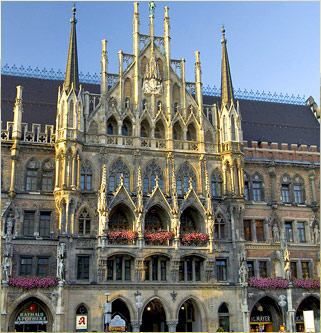 |
 |
|||||||||||||||||||||||
|
|
||||||||||||||||||||||||
 |
|||||
|
Perhaps best known among young travelers for the infamous revels of Oktoberfest, Munich is one of Germany’s most popular tourist destinations. It is ranked as the third largest city in Germany, and serves as the capital of postcard-perfect Bavaria. The city itself contains a mix of fairytale gothic architecture, medieval churches and cutting edge modern museums. Because the city was very heavily damaged by allied bombing during World War II, Munich was completely rebuilt adhering to a meticulous blueprint of its pre-war street grid. The city now boasts the reputation as being one of Europe’s most prosperous cities, with BMWs, swanky restaurants, a staggering array of museums and a vibrant arts scene. There are year-round festivals and celebrations. Even in the winter time, when being outside is not much fun, you can easily find a welcoming bierhaus to relax and enjoy some Bavarian hospitality. So, don some lederhosen, grab your mug and kick back in one of Munich’s beer gardens for a quintessential Bavarian experience. |
|||||
|
Obviously, the prime time to visit Munich is when the weather is beautiful and the scenery is at its optimum. But this also means joining the tourist rush between May and September. For those who are willing to be a little more adventurous and don’t mind risking the weather, it is well worth considering visiting the region during the April-May and September-October periods, as there are fewer visitors and plenty of sunny days and brisk evenings. Oktoberfest Rathaus-Glockenspiel Frauenkirche--Cathedral of Our Lady Dachau Concentration Camp Memorial Site |
|||||
 |
|
[Home] [Contestants] [Destinations] [Episodes] [Leaderboards] [Route Map] [Teams] |
|
All THE AMAZING RACE related graphics and photos on this page are copyright 2006 CBS Broadcasting Inc. |